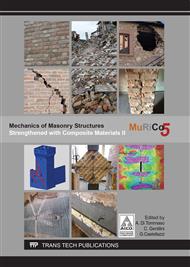[1]
H. Houben, H. Guillaud H., Earth Construction: A Comprehensive Guide, third ed., CRATerre - EAG Intermediate Technology Publication, London, (2008).
Google Scholar
[2]
P. A. Jaquin, C.E. Augarde, C.M. Gerrard, Chronological description of the spatial development of rammed earth techniques, International Journal of Architectural Heritage 2. 4 (2008) 377-400.
DOI: 10.1080/15583050801958826
Google Scholar
[3]
G. Minke, Building with earth, design and technology of a sustainable architecture, Birkhäuser - Publishers for Architecture, Basel- Berlin-Boston, (2006).
Google Scholar
[4]
M. Correia, Rammed earth in Alentejo, Argumentum, Lisbon, (2007).
Google Scholar
[5]
L. Lacouture, C. Bernal, J. Ortiz, D. Valencia, Studies on seismic vulnerability, rehabilitation and strengthening of adobe and rammed earth houses, Apuntes 20. 2 (2007) 286-303. (in Spanish).
Google Scholar
[6]
D.V. Oliveira, R.A. Silva, P.B. Lourenço, L. Schueremans, Rammed earth constructions and the earthquakes, In proc. of Congresso Nacional de Sismologia e Engenharia - SÍSMICA 2010, Aveiro, 2010 (in Portuguese).
Google Scholar
[7]
O. Domínguez, Preservation and repair of rammed earth constructions, MSc. thesis, University of Minho, Guimarães, (2015).
Google Scholar
[8]
B. Ghiassi, D.V. Oliveira, V. Marques, E. Soares, H. Maljaee, Multi-level characterization of steel reinforced mortars for strengthening of masonry structures, Materials & Design 110 (2016) 903-913.
DOI: 10.1016/j.matdes.2016.08.034
Google Scholar
[9]
C.G. Papanicolaou, T.C. Triantafillou, M. Papathanasiou, K. Karlos, Textile reinforced mortar (TRM) versus FRP as strengthening material of URM walls: out-of-plane cyclic loading, Materials and Structures 41. 1 (2008) 143-157.
DOI: 10.1617/s11527-007-9226-0
Google Scholar
[10]
A. Figueiredo, H. Varum, A. Costa, D. Silveira, C. Oliveira, Seismic retrofitting solution of an adobe masonry wall. Materials and Structures 46. 1 (2013), 203-219.
DOI: 10.1617/s11527-012-9895-1
Google Scholar
[11]
ASTM D6637-11, Standard Test Method for Determining Tensile Properties of Geogrids by the Single or Multi-Rib Tensile Method. ASTM International, West Conshohocken, (2011).
DOI: 10.1520/d6637_d6637m-15
Google Scholar
[12]
R.A. Silva, D.V. Oliveira, L. Schueremans, T. Miranda, J. Machado, Effectiveness of the repair of unstabilised rammed earth with injection of mud grouts, Construction and Building Materials 127 (2016) 861-871.
DOI: 10.1016/j.conbuildmat.2016.10.064
Google Scholar
[13]
U. Röhlen, C. Ziegert, (2011). Earth Building Practice. Planning, Design, Building, first ed, Beuth Verlag, Berlim, (2011).
Google Scholar
[14]
J.L. Almeida, Traditional and industrial mortars for masonry of buildings, MSc. thesis, University of Porto, Porto, 2010. (in Portuguese).
Google Scholar
[15]
EN 1015-3, Methods of test for mortar for masonry - Part 3: Determination of consistence of fresh mortar (by flow table). European Committee for Standardization, Brussels, (2004).
DOI: 10.3403/01541440
Google Scholar
[16]
M.I. Gomes, Conservation of rammed earth construction: repairing mortars, PhD thesis, Universidade Nova de Lisboa, Lisbon, 2013. (in Portuguese).
Google Scholar
[17]
P. Walker, HB 195: The Australian earth building handbook, Australia: Standards Australia Internacional Ltd, Sydney, (2001).
Google Scholar
[18]
EN 1015-11: Methods of test for mortar for masonry - Part 11: Determinations of flexural and compressive strength of hardened mortar. European Committee for Standardization, Brussels, (1999).
DOI: 10.3403/01905442
Google Scholar
[19]
M. R Valluzzi et al., Round robin test for composite-to-brick shear bond characterization, Materials and Structures 45. 12 (2012) 1761-1791.
Google Scholar


